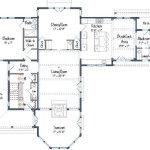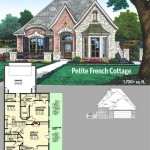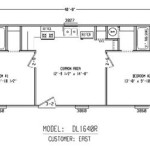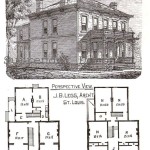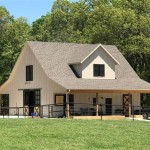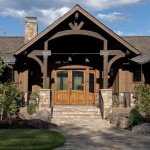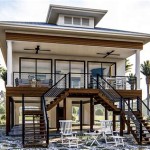Home Plans With Detached In-Law Suite: Exploring Options and Considerations
The demand for housing solutions that accommodate multigenerational living has surged in recent years. This trend has led to increased interest in home plans featuring detached in-law suites, also known as accessory dwelling units (ADUs), granny flats, or backyard cottages. These separate living spaces offer independence and privacy for both the homeowner and their relatives, while fostering closer family bonds and providing potential rental income opportunities.
A detached in-law suite is a self-contained living unit separate from the main house on the same property. It typically includes a bedroom, bathroom, living area, and kitchen. The detachment from the main residence provides a distinct sense of autonomy and minimizes disruptions between the occupants. This arrangement differs significantly from an attached in-law suite, which is directly connected to the main house and often shares a common wall or entrance.
Choosing a home plan with a detached in-law suite requires careful consideration of various factors, including local zoning regulations, building codes, design preferences, budget constraints, and the specific needs of the individuals who will be occupying the suite. This article will explore key aspects of planning and designing homes with detached in-law suites, providing valuable information for homeowners considering this type of accommodation.
Understanding Zoning Regulations and Building Codes
Before embarking on any construction project, it is essential to thoroughly investigate and comply with local zoning regulations and building codes. These regulations vary considerably from one municipality to another and can significantly impact the feasibility and design of a detached in-law suite. Zoning codes often address issues such as minimum lot size, setback requirements, height restrictions, parking regulations, and allowable density.
Setback requirements dictate the minimum distance that a structure must be set back from property lines. Height restrictions limit the maximum height of buildings, including detached in-law suites. Parking regulations may require the provision of additional parking spaces for the occupants of the suite. Allowable density refers to the maximum number of dwelling units allowed per acre of land. These regulations are in place to maintain neighborhood character, ensure adequate infrastructure, and address concerns related to traffic congestion and environmental impact.
Building codes, on the other hand, focus on the safety and structural integrity of buildings. They specify requirements for materials, construction methods, electrical wiring, plumbing, and mechanical systems. Compliance with building codes is crucial to ensure the safety of occupants and prevent potential hazards such as fires, structural collapses, and health risks. Obtaining the necessary permits is also a critical aspect of the process. Building permits ensure that the proposed construction meets all applicable regulations and that the project is subject to inspection by local authorities.
Engaging with local planning and building departments is paramount to avoid potential legal issues and costly delays. These departments can provide guidance on specific regulations and requirements, help navigate the permitting process, and address any questions or concerns. Failure to comply with zoning regulations and building codes can result in fines, stop-work orders, or even the forced removal of the unpermitted structure.
Designing for Functionality and Privacy
Effective design is crucial for creating a detached in-law suite that is both functional and provides adequate privacy for all occupants. The design should consider the specific needs and preferences of the individuals who will be living in the suite, as well as the overall aesthetic of the property. Space planning is a critical aspect of the design process. The layout should maximize the use of available space and create a comfortable and livable environment. Consider incorporating universal design principles to ensure accessibility for individuals with mobility limitations. This may include features such as wider doorways, grab bars in bathrooms, and ramped entrances.
Privacy is a key consideration when designing a detached in-law suite. The orientation of the suite should be carefully planned to minimize visual and auditory intrusions between the main house and the suite. Strategic placement of windows and doors can help to maximize natural light while maintaining privacy. Landscaping can also play a significant role in enhancing privacy. Trees, shrubs, and fences can create a visual barrier and reduce noise transmission.
The design should also consider the functionality of the suite as a self-contained living unit. A well-equipped kitchen is essential, including appliances such as a refrigerator, stove, microwave, and dishwasher. Adequate storage space should be provided for clothing, personal belongings, and household items. A comfortable living area is also important, providing a space for relaxation and entertainment. A private outdoor space, such as a patio or deck, can enhance the enjoyment of the suite and provide a connection to the outdoors.
Attention to detail is essential in creating a detached in-law suite that is both functional and aesthetically pleasing. Consider incorporating design elements that complement the style of the main house while giving the suite its own distinct character. High-quality materials and finishes can enhance the overall look and feel of the suite. Thoughtful design can contribute significantly to the comfort, privacy, and overall living experience for the occupants of the detached in-law suite.
Budgeting and Cost Considerations
Establishing a realistic budget is crucial for successfully constructing a detached in-law suite. The cost of construction can vary significantly depending on factors such as the size of the suite, the complexity of the design, the quality of materials used, and the location of the property. It is essential to obtain detailed cost estimates from reputable contractors and to factor in contingencies for unexpected expenses.
Several factors contribute to the overall cost of building a detached in-law suite. Site preparation can involve clearing land, grading, and excavation, which can add significantly to the cost. Foundation work is another major expense, as it involves pouring concrete and ensuring the structural stability of the building. Framing, roofing, and siding are also significant cost components, as they determine the overall structure and appearance of the suite.
Interior finishes, such as flooring, drywall, paint, and trim, can also impact the budget. The cost of appliances, plumbing fixtures, and electrical systems should also be considered. Landscaping and outdoor amenities can further add to the overall cost. Obtaining multiple bids from different contractors is recommended to ensure competitive pricing. It is also important to carefully review the scope of work outlined in each bid and to ensure that all necessary items are included.
Exploring financing options is also essential. Home equity loans, personal loans, and construction loans are common sources of funding for building a detached in-law suite. Consider the interest rates, repayment terms, and associated fees when evaluating different financing options. It is also important to factor in the potential increase in property taxes resulting from the addition of the suite. A well-planned budget and careful management of expenses are crucial for completing the project on time and within budget.
Beyond initial construction costs, consider the ongoing expenses associated with the suite. Utility bills, such as electricity, gas, and water, will increase. Property taxes may also rise due to the increased value of the property. Regular maintenance and repairs will also be necessary to keep the suite in good condition. These ongoing expenses should be factored into the overall financial planning process.
Careful planning and diligent execution are essential for successfully integrating a detached in-law suite into a property. By considering the factors outlined above, homeowners can create a comfortable, functional, and private living space that meets the needs of their family and enhances the value of their property.
Choosing the right home plan with a detached in-law suite requires a thorough assessment of individual needs, local regulations, and financial resources. By addressing these considerations, homeowners can make informed decisions and create a living arrangement that benefits all family members.
Successfully navigating the planning and construction of a detached in-law suite relies on a comprehensive understanding of local regulations, thoughtful design principles, and meticulous budget management. These elements, when combined effectively, can transform the concept of multigenerational living into a practical and harmonious reality.

Homes With Mother In Law Suites

House Plans With In Law Suites Houseplans Blog Com

In Law Suite Plans Give Mom Space And Keep Yours The House Designers

Country House Plan With 4 Bedrooms And 3 5 Baths 4427

Plan 65862 Tuscan Style House Floor Plans With 2091 Sq Ft 3 Be

Exclusive 4 Bed House Plan With Detached In Law Suite 93109el Architectural Designs Plans

One Story With In Law Suite Plan 2286

House Plans With In Law Suites Houseplans Blog Com

Arts And Crafts Country Home With 5 Bedrms 2473 Sq Ft Plan 108 1692

So I Have A Project Where Am Designing Main House And An Attached Mother In Law Suite The Is Guest Plans Family

